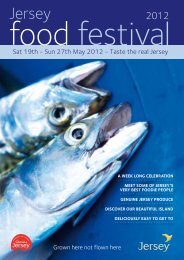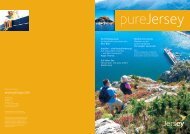Spring-Summer Pure Jersey Part 1 with adverts:jersey Cover AW
Spring-Summer Pure Jersey Part 1 with adverts:jersey Cover AW
Spring-Summer Pure Jersey Part 1 with adverts:jersey Cover AW
You also want an ePaper? Increase the reach of your titles
YUMPU automatically turns print PDFs into web optimized ePapers that Google loves.
Life and<br />
Liberty<br />
<strong>Jersey</strong>’s experiences during World War Two have left<br />
enduring memories. When your liberty is taken away,<br />
you don’t forget in a hurry. Broadcaster Sue Cook, who<br />
has presented everything from the Holiday programme to<br />
Radio 4’s popular Making History, looks at how the <strong>Jersey</strong><br />
of today remembers all its yesterdays.<br />
22 pure<strong>Jersey</strong><br />
LIBERATION FESTIVITIES LIBERATION SQUARE, ST HELIER<br />
to <strong>Jersey</strong> – the ideal<br />
wartime holiday resort!’ exhorted<br />
‘Come<br />
the brochures. ‘The bays <strong>with</strong><br />
their eternal sands, sea and sunshine<br />
together produce an atmosphere of<br />
peaceful tranquillity…’<br />
It was May 1940. In Europe, World War<br />
Two was well underway. By contrast,<br />
<strong>Jersey</strong>’s sandy beaches remained bathed in<br />
quiet sunshine. There was no reason to<br />
expect otherwise. After all, the First World<br />
War had passed the Channel Islands by.<br />
Why would the second be any different?<br />
‘Happily, our island is far removed from the<br />
theatre of war,’ the brochure went on to<br />
say. If only. Six weeks later, on July 1st,<br />
1940, that ‘peaceful tranquillity’ was<br />
shattered when the German Luftwaffe<br />
bombed St Helier. Two more days and<br />
Hitler’s forces had landed. The island was<br />
under German rule for the best part of the<br />
next five years. Deliverance arrived on May<br />
9th 1945, the day after VE Day, when the<br />
British Navy sailed into St Helier. It was an<br />
occasion of such relief that, more than 60<br />
years on, the annual Liberation Day<br />
festivities on May 9th are still hugely<br />
important on the island.<br />
Not one to miss a good celebration, I arrive<br />
the morning before the big day. I am booked<br />
into the famous Pomme d’Or Hotel,<br />
headquarters for Hitler’s Navy during the<br />
Occupation. It stands in Liberation Square<br />
and I stop to admire the striking memorial<br />
statue depicting the moment occupation<br />
became liberation: seven bronze figures – six<br />
islanders and a British soldier – triumphantly<br />
holding aloft a giant Union Jack.<br />
An estate car pulls up <strong>with</strong> a trailer loaded<br />
<strong>with</strong> chairs. Volunteers busy themselves<br />
setting them out in rows. In front of them a<br />
stage is being assembled – the focal point<br />
of tomorrow’s ceremony when the guest of<br />
honour will be His Royal Highness the Duke<br />
of Kent. The party atmosphere is already<br />
beginning to build.<br />
From my room at the Pomme d’Or<br />
overlooking the square and harbour, I’ll<br />
have a grandstand view of tomorrow’s<br />
proceedings. No time to unpack now, I’m<br />
due to meet Tom Bunting, one of <strong>Jersey</strong>’s<br />
Blue Badge guides and an expert on the<br />
island’s wartime heritage.<br />
We meet at the appropriately named<br />
Gunsite Café, a converted German-built<br />
concrete command post overlooking sandy<br />
St Aubin’s Bay. Its tranquil pale-blue décor,<br />
chalk-written menu boards and sea view<br />
make it hard to visualise its warlike<br />
function. Over fresh orange juice and<br />
home-baked carrot cake Tom tells me that<br />
most of the old German bunkers and gun<br />
emplacements are still in evidence. Instead<br />
of destroying them, the ever-practical and<br />
resourceful islanders have put them to<br />
good use. One, filled <strong>with</strong> sea-water, is a<br />
storehouse for freshly caught lobsters.<br />
Others serve as a turbot farm and a<br />
museum filled <strong>with</strong> relics and artefacts<br />
from the Occupation. Yet another has<br />
become a cycle hire shop.<br />
Similarly, the concrete sea-walls the Germans<br />
built all round the island are still doing their job<br />
so efficiently that there’s no need to replace<br />
them. As I discover later in the day, these and<br />
other wartime relics have a strange beauty<br />
all of their own, their presence amongst<br />
sea-cliffs and headlands fusing brutality <strong>with</strong><br />
beauty much in the same way as a medieval<br />
castle in a mountain setting.<br />
Later, Tom promises, he’ll show me the<br />
Corbière Radio Tower on the west coast,<br />
once a German observation post, now<br />
converted into a six-storey holiday home<br />
<strong>with</strong> stunning 360-degree views across<br />
ocean and field. When I see it I can’t help<br />
thinking that it mirrors its near neighbour,<br />
the Corbière Lighthouse, a famous <strong>Jersey</strong><br />
landmark on the rocks below. If so, it’s by<br />
happy accident – I doubt that the Germans<br />
planned it that way.<br />
But first, Tom’s going to take me on his<br />
‘Living <strong>with</strong> the Enemy’ walk, which proved<br />
an instant hit <strong>with</strong> <strong>Jersey</strong>’s visitors when he<br />
introduced it in 2006. It’s a two-mile<br />
wooded stroll from the Gunsite Café to the<br />
astonishing <strong>Jersey</strong> War Tunnels (more on<br />
these later). We set off along an idyllic<br />
country lane, crossing a mill stream before<br />
finding a wooded trail almost hidden<br />
between the trees. As we walk, Tom talks<br />
about the harsh reality of life for the people<br />
of <strong>Jersey</strong> under German rule.<br />
1 book online at www.<strong>jersey</strong>.com 23
















